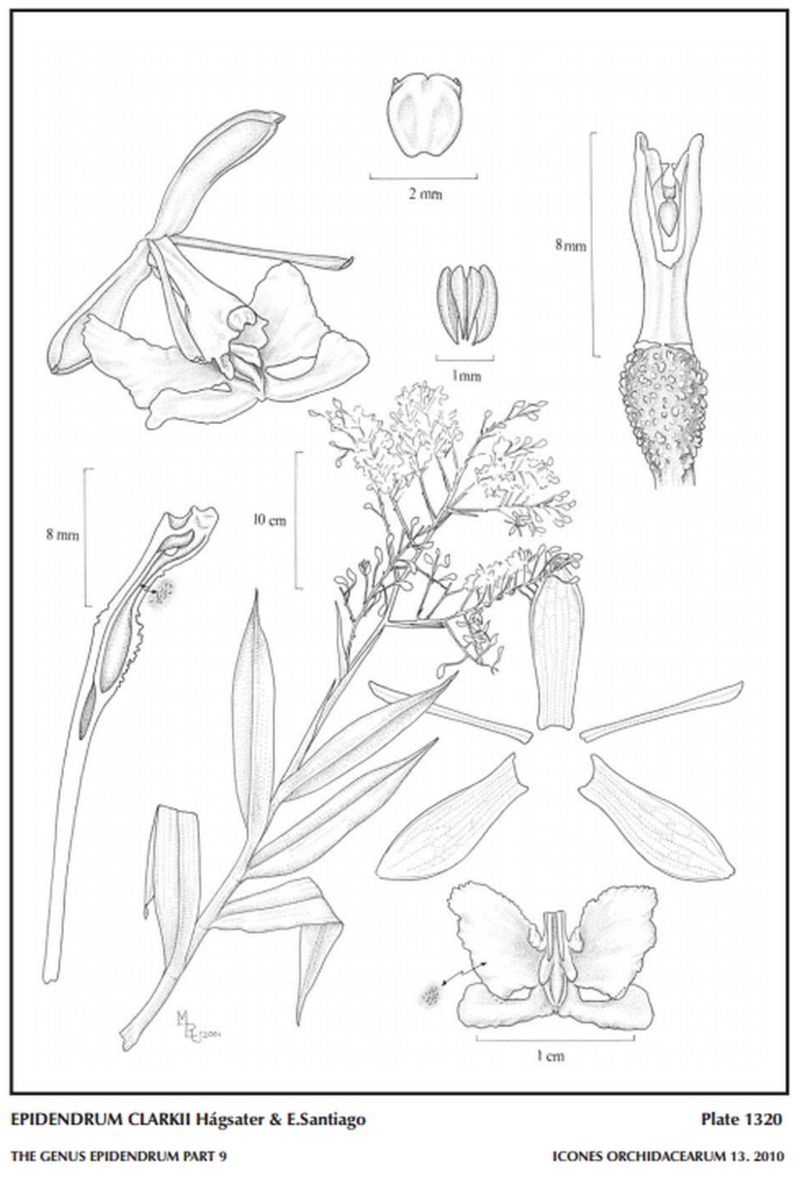

Epidendrum clarkii Hágsater & E.Santiago 2010 GROUP Pseudepidendrum SUBGROUP Porphyreum
TYPE Drawing by © M. Lopex R. and The AMO Herbaria Website




Common Name Clark's Epidendrum [American Botanist collected in Ecuador current]
Flower Size .8" [2 cm]
Found in north central Ecuador on the Pacific coast of the Andes at elevations of 1100 to 2300 meters as a cool to cold growing terrestrial or rarely epiphyte with simple, cane-like stems basally terete, laterally compressed towards the apex, erect, straight stems carrying 9 to 10, all along the upper half of the stem, articulate, distichous, narrowly elliptic, shortly acuminate, subcoriaceous, margin entire leaves that blooms in the summer on a terminal, erect, paniculate, peduncle thin, laterally compressed, straight, totally covered by 2 to 4, tubular, somewhat ancipitose, acuminate, partly imbricating bracts, rachis with 5 to 10, spreading racemes, each many flowered and provided with a basal narrowly triangular, acuminate, amplexicaul bract, 12" [30 cm] long overall, successively 50 to 220 flowered inflorescence and carrying resupinate flowers with lilac rose tepals and a whitish lip.
"Epidendrum clarkii belongs to the GROUP Pseudepidendrum is characterized by caespitose plants, cane-like stems, acute to acuminate leaves, apical inflorescence, lacking a spathaceous bract, the petals filiform and the lip usually 3-lobed, with 3 parallel fleshy keels, the apical lobe often bifurcate, and the pollinia “bird-wing” type and the SUBGROUP Porphyreum which has flowers colored reddish orange, deep purple or lilac-pink, the calli generally prominent, sometimes horn-like. The species is recognized by the successive, pink-lilac flowers with the disc th whitish, sepals .4 to .44" [10 to 11 mm] long, the apical 1/5 of the ovary ventrally inflated and muricate the lip with lateral lobes falcate-trapezoid, and the prominent calli. It is very close to Epidendrum nanegalense which has simultaneous, purple flowers with the ovary inflated but smooth, the lateral lobes of the lip dolabriform, not falcate, and the calli small and short. Epidendrum porphyreum Lindl. has similarly colored flowers but somewhat larger, sepals .52 to .6" [13 to 15 mm] long, dorsally verrucose, the ovary is not inflated and the lateral lobes of the lip are dolabriform, not falcate.Epidendrum englerianum F.Lehm. & Kraenzl. has short plants, to 20" [50 cm] tall, simultaneous, purple/pink to greenish/white flowers, sepals .4 to .52" [10 to 13 mm] long, the ovary thin, and the lateral lobes of the lip falcate-oblong. Epidendrum laeve Lindley 1844 has similar flowers, but the ovary is not inflated, and the mid-lobe of the lip has a deep sinus and the two apical lobes are slightly divaricate, with the width of the lip similar at the apex as at the base." Hagsater etal 2010
Synonyms
References W3 Tropicos, Kew Monocot list , IPNI ; *Icones Orchidacearum 13 Plate 1320 Hagsater & Santiago 2010 Drawing fide; Icones Orchidacearum 13 Plate 1339 Hagsater & Dodson 2010 See Recognition section;
--------------------------------------------------------------------------------------------------------------------------